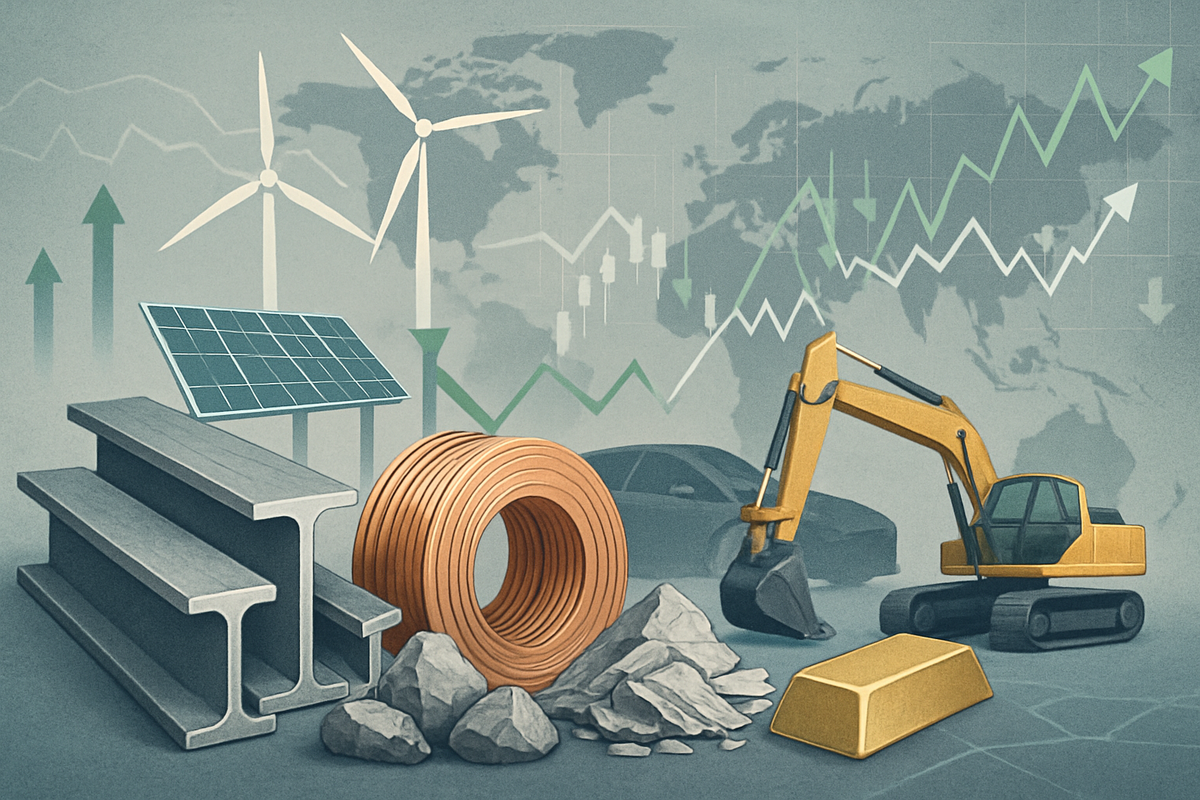Financial News
Materials Sector Navigates Volatility Amidst Green Transition and Global Headwinds on September 30, 2025

As the financial markets close on September 30, 2025, the Materials sector presents a complex and bifurcated picture, reflecting the ongoing tug-of-war between global economic uncertainties and the powerful, long-term tailwinds of the energy transition and infrastructure development. While immediate concerns about a global economic slowdown and persistent inflationary pressures have introduced volatility, the underlying demand for critical minerals and sustainable materials continues to shape a transformative outlook for the industry. This report provides a forward-looking analysis based on current trends and expert projections, acknowledging that real-time market data for this future date is not available.
The sector's performance today, while experiencing some dips reflective of broader investor caution, is fundamentally influenced by a blend of moderating commodity prices, evolving global demand patterns, robust infrastructure spending initiatives, and dynamic supply chain recalibrations. Notably, the steel industry, a foundational component of the Materials sector, is at a critical juncture, balancing global overcapacity with strong regional demand and the imperative to decarbonize. The broader narrative suggests that companies adept at innovation, sustainability, and supply chain resilience are best positioned to navigate these turbulent waters.
Projected Trends and Key Drivers Shaping the Materials Landscape
The Materials sector, a bellwether for global economic health, is anticipated to be influenced by several key drivers around September 30, 2025. Commodity prices are exhibiting mixed signals: while global oil prices are generally forecasted to decline due to increased OPEC+ production, natural gas prices are expected to rise. In metals, copper is projected to benefit from attractive long-term supply-and-demand dynamics despite short-term fluctuations, with silver seeing a strong rally driven by both safe-haven and industrial demand from solar energy and electric vehicles (EVs). Gold prices are also projected to continue their upward trajectory. However, steel and iron ore prices show potential for downward trends into early 2026, influenced by global overcapacity and China's economic shifts. Battery materials like lithium are expected to see a price recovery, fueled by soaring LFP (lithium iron phosphate) cathode output and booming energy storage demand.
Global demand is increasingly bifurcated. While traditional construction materials face some headwinds, demand for advanced materials (composites, nanomaterials) across aerospace, electronics, automotive, and clean energy industries is projected for significant growth. The push for sustainable materials, including bio-based options and increased recycling, is becoming a non-negotiable aspect of procurement. Infrastructure spending remains a bright spot, with worldwide investments projected to exceed US$9 trillion per year by 2025, particularly in emerging markets and the US, driven by federal initiatives and the green transition. This spending fuels demand for a wide array of construction and industrial materials.
Supply chain dynamics continue to be a critical factor. Geopolitical tensions, such as ongoing trade disputes and maritime disruptions, contribute to elevated freight costs and lead times. Companies are increasingly adopting strategies like diversification, improved inventory management, and localized manufacturing (reshoring/nearshoring) to build more resilient and agile supply chains. Technological innovations, including AI for real-time monitoring and demand forecasting, are playing a crucial role in enhancing operational efficiency and mitigating risks. The overarching trends of sustainability, digitalization, and geopolitical influence are fundamentally reshaping how materials are produced, distributed, and consumed globally.
Companies Poised for Gains and Challenges
The projected trends around September 30, 2025, create distinct opportunities and challenges for public companies within the Materials sector, particularly steel manufacturers.
Likely Winners:
- Domestic US Steel Producers: Companies like Nucor (NYSE: NUE), Steel Dynamics (NASDAQ: STLD), and Cleveland-Cliffs (NYSE: CLF) are expected to benefit significantly from the 25% US tariffs on imported steel and aluminum, which make their domestic products more competitive. Coupled with anticipated growth in the US construction industry and federal infrastructure spending, these companies are poised for increased market share, potentially higher prices, and improved margins. Their strategic outlook is strengthened by a protected domestic market and government-backed projects.
- ArcelorMittal (NYSE: MT): As a major global steel producer, ArcelorMittal is strategically positioned to benefit from robust growth in demand for Advanced High-Strength Steel (AHSS) driven by EV production. Furthermore, the company's proactive investments in green steel technologies and decarbonization initiatives align with increasing regulatory pressures, such as the EU's Carbon Border Adjustment Mechanism (CBAM) effective in 2026, and growing customer demand for sustainable products. While exposed to global cyclicality, its focus on high-value segments could provide more stable revenue streams.
- Rio Tinto (NYSE: RIO): This major iron ore miner is favored for its expected near-term volume growth, which could help maintain revenue despite a projected moderation of iron ore prices around $100/ton in 2025. In a moderately surplus market, companies capable of increasing output and maintaining cost efficiency will be better positioned.
Likely Losers / More Challenged:
- Steel Exporters to the US: Producers from countries like Canada, Mexico, and certain Asian/European nations that heavily rely on the US market will face significant headwinds due to the 25% US tariffs. These tariffs increase their costs, reduce competitiveness, and make it difficult to redirect substantial export volumes in an already oversupplied global market, leading to reduced sales and revenue.
- Traditional Blast Furnace (BF/BOF) Steelmakers without Significant Decarbonization Investments: Globally, steelmakers slow to adopt greener production methods will face increasing regulatory pressure and higher operating costs from carbon pricing mechanisms. The enormous capital investments required for transitioning to electric arc furnaces (EAFs) or hydrogen-based reduction methods will challenge companies without robust decarbonization plans, potentially eroding margins and market access.
- Jastrzebska Spotka Weglowa SA (JSW): As a coking coal producer, JSW is directly sensitive to coking coal price fluctuations. While prices are forecast to average around $220/ton in 2025, a long-term downward trend is anticipated as blast furnace steel production slows globally. JSW's recent negative financials highlight its vulnerability to these market shifts, and its strategic outlook depends heavily on cost management amidst the broader industry move away from carbon-intensive steelmaking.
Wider Significance and Broader Industry Shifts
The Materials sector's performance around September 30, 2025, carries wider significance, reflecting and influencing several broader industry patterns. The most dominant theme is the accelerating shift towards sustainability and a circular economy. Policy mandates, corporate climate goals, and investor scrutiny are driving demand for green building materials, recyclable options, and low-embodied carbon products. Regulations like the EU's CBAM are fundamentally reshaping trade and production methods for energy-intensive materials like cement, steel, and aluminum, pushing companies to invest heavily in decarbonization.
Technological innovations are also profoundly impacting the sector. Industry 4.0 advancements, including AI, machine learning, and data management, are accelerating material development, leading to new composites, nanomaterials, and smart materials for diverse applications. This technological thrust is not only about new products but also about optimizing production processes and enhancing supply chain visibility.
The persistent geopolitical and macroeconomic factors continue to fragment markets and shift trade flows. Trade protectionism, evidenced by US tariffs on steel, aluminum, and other materials, is reshaping global supply chains and increasing material costs. China's uneven economic recovery, particularly in its real estate sector, remains a critical determinant for global demand for industrial metals, while its energy transition efforts also create new demand for specific critical minerals.
These trends have significant ripple effects on downstream industries. Manufacturing and construction sectors are directly impacted by fluctuating raw material prices and supply chain disruptions, which can compress margins. Industries focused on the energy transition, such as electric vehicles and renewable energy, are experiencing robust demand for critical minerals but also face supply challenges, as seen with the 2025 copper supply disruption. The chemical industry is also undergoing a transformation towards green chemistry and bio-based materials. Historically, commodity markets are cyclical, with price fluctuations often mirroring global economic activity and geopolitical events, as observed during the 2007-09 financial crisis and the recent pandemic-induced supply shortages.
What Comes Next: Navigating the Future Landscape
Looking ahead, the Materials sector faces a landscape defined by both immediate challenges and compelling long-term opportunities. In the short term (Q4 2025 - 2026), persistent high interest rates (despite recent Fed cuts) and a slowdown in China continue to weigh on performance. Inflationary pressures mean rising material costs could compress manufacturers' margins. However, potential global monetary easing and further economic stimulus in China could create a more favorable environment, particularly for interest-rate-sensitive segments like chemicals.
The long-term outlook (beyond 2026) is fundamentally more optimistic, driven by the energy transition, which creates unprecedented demand for critical minerals (copper, nickel, lithium) essential for EVs, batteries, and renewable energy infrastructure. The global metals and minerals market is projected for significant growth, with recycling playing a critical role in meeting future demand.
Companies will need to implement several strategic pivots and adaptations:
- Diversification and R&D: Investing in advanced materials and R&D (composites, nanomaterials) for high-growth applications.
- Supply Chain Optimization: Reshoring or "friendshoring" supply chains to reduce geopolitical vulnerabilities and improve resilience.
- Sustainability and Circular Economy: A strong focus on decarbonization, green materials, and circular economy principles to meet regulatory and customer demands.
- Digital Transformation: Embracing AI and analytics for enhanced visibility, operational efficiency, and demand forecasting.
- Capital Reallocation: Strategic M&A and divestments to focus on higher-growth, lower-risk segments.
Emerging market opportunities are significant in India and Southeast Asia, driven by robust infrastructure spending and urbanization. Conversely, challenges persist in China, where moderating demand for traditional construction metals and property sector weakness continue to impact global markets. Geopolitical tensions and tariffs also remain significant challenges, impacting trade flows and increasing costs.
Potential scenarios for commodity prices include declining oil prices due to oversupply, rising natural gas prices due to increased US LNG exports, and sustained but tempered demand for industrial metals, with copper and lithium showing strong long-term potential. Gold prices are expected to continue their ascent, driven by safe-haven demand. Global demand is expected to maintain a moderate pace, with emerging markets outperforming advanced economies. Infrastructure spending globally, especially in the US and India, will continue to be a major demand driver for materials, though challenges like high material costs and labor shortages could cause delays.
Comprehensive Wrap-Up and Investor Outlook
The Materials sector around September 30, 2025, is defined by a dynamic interplay of macroeconomic headwinds and powerful structural tailwinds. While short-term volatility, driven by global economic concerns and fluctuating commodity prices, remains a factor, the sector is undergoing a fundamental transformation. The energy transition stands out as the most significant long-term driver, creating unprecedented demand for critical minerals vital to electric vehicles, renewable energy, and battery storage. This, coupled with robust global infrastructure spending and a pervasive shift towards sustainable practices, signals a profound and lasting impact on the industry.
Key takeaways include the delicate balance between macroeconomic challenges and structural growth, the pivotal role of monetary policy in influencing borrowing costs and investment, the paramount importance of critical minerals, and the ongoing vulnerabilities within global supply chains. Sustainability is no longer a niche but a core driver, reshaping production methods and consumer preferences.
Moving forward, the market will be shaped by continued global monetary easing and a potential recovery in key economies like China. However, material cost inflation, energy price instability, and labor shortages will continue to challenge certain sub-sectors, particularly construction materials. Geopolitical developments and their impact on commodity prices will require constant vigilance.
The lasting impact of these trends will be a Materials sector that is more diversified, technologically advanced, and deeply integrated with the principles of sustainability and circularity. The unprecedented demand for green materials and critical minerals will reshape resource allocation and technological innovation for decades.
For investors, a nuanced and selective strategy is paramount.
- Monitor Macroeconomic Signals: Keep a close watch on global growth, inflation, and central bank policies.
- Focus on Critical Minerals: Prioritize sub-sectors involved in copper, nickel, lithium, and cobalt, essential for the energy transition.
- Evaluate Precious Metals: Gold miners and royalty companies may continue to offer strong performance due to safe-haven demand and reduced cost pressures.
- Assess Advanced Materials and Chemicals: Look for companies investing in specialty chemicals and advanced materials for high-performance solutions, particularly those focused on green chemistry.
- Consider Supply Chain Resilience: Favor companies that have diversified suppliers and adopted nearshoring/reshoring strategies.
- Be Selective in Construction Materials: While some growth is projected, be cautious due to material cost inflation and labor shortages.
- Watch for M&A Activity: Consolidation in the mining sector, especially among smaller players, could present long-term upside.
- Risk Management: Remain vigilant about geopolitical developments, trade policies, and commodity price volatility.
This content is intended for informational purposes only and is not financial advice.
More News
View More




Recent Quotes
View More
Quotes delayed at least 20 minutes.
By accessing this page, you agree to the Privacy Policy and Terms Of Service.



